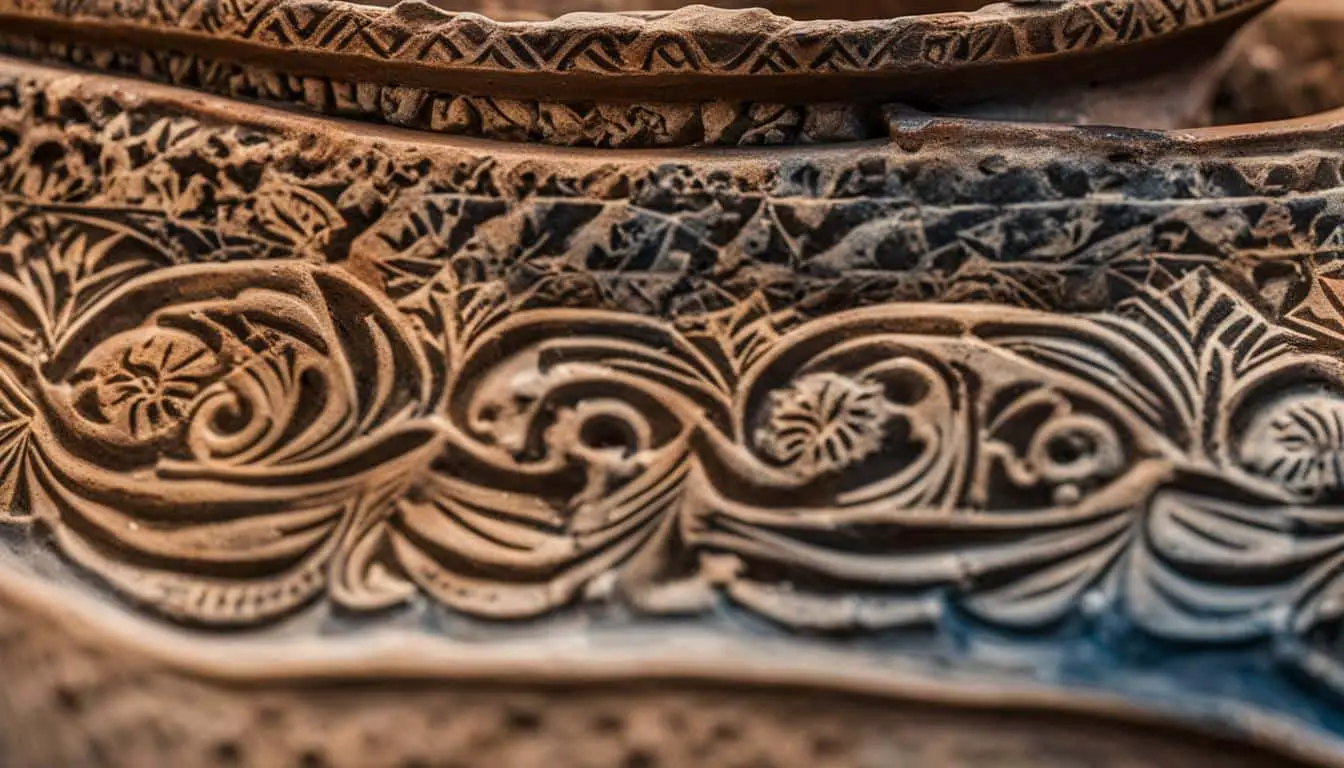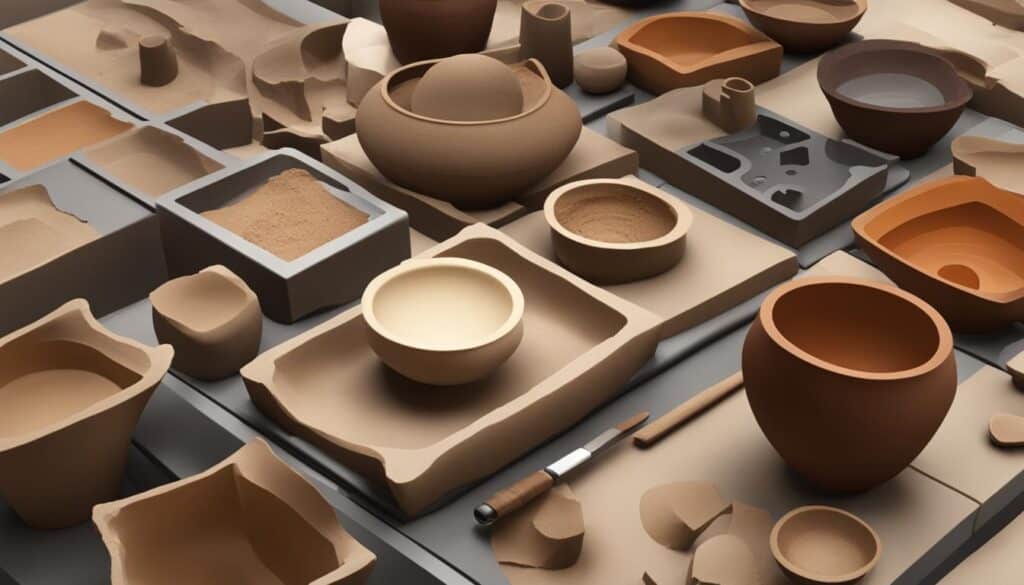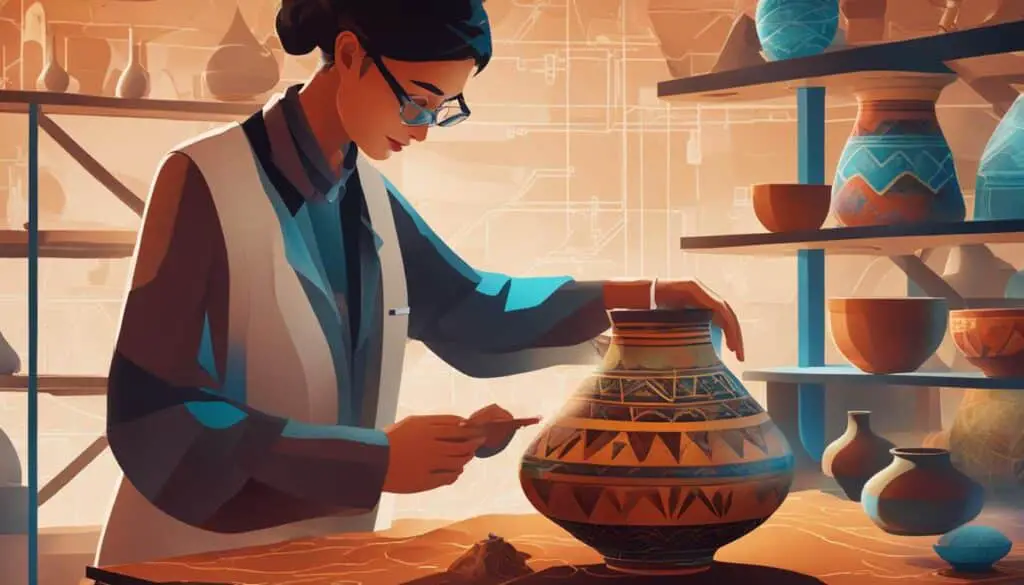
As an archaeologist specializing in the study of biblical-era pottery, I am constantly amazed by how chemical analysis techniques have revolutionized our understanding of ancient civilizations. By scrutinizing the composition of these ancient artifacts, we can uncover invaluable insights about the materials used, manufacturing techniques employed, trade routes, and cultural significance of pottery during biblical times.
The application of chemical analysis techniques in the study of biblical-era pottery opens up a world of possibilities for researchers. This article will delve into the cutting-edge research techniques that have transformed our understanding of these ancient artifacts.
Key Takeaways:
- Chemical analysis techniques offer valuable insights into biblical-era pottery.
- By examining the composition of pottery, researchers can uncover information about the materials used, manufacturing techniques, and cultural significance.
- Advanced techniques such as X-ray fluorescence spectroscopy, petrography, and infrared spectroscopy are employed in chemical analysis.
- Case studies using chemical analysis have revealed distinctive clay sources, production centers, and dietary habits of ancient civilizations.
- Limitations and future directions in the field include the development of non-destructive analysis techniques and the integration of data from multiple sources.
Importance of Chemical Analysis in Archaeology
Chemical analysis has revolutionized the field of archaeology by providing a scientific approach to the study of ancient civilizations. Through the meticulous examination of artifacts such as pottery, archaeologists can uncover invaluable insights into the mysteries of the past. By analyzing the chemical composition of these objects, they can determine the geographic origin of the materials used, identify production techniques, and even trace patterns of cultural exchange and trade between different regions. This information helps build a more comprehensive understanding of ancient civilizations and the intricate web of connections that shaped their societies.
In the realm of archaeology, chemical analysis serves as a powerful tool to unlock the secrets of ancient civilizations. It provides tangible evidence that breathes life into historical narratives, offering a deeper understanding of the cultural, economic, and social dynamics of the past. Findings from chemical analysis are integral to constructing a holistic picture of ancient societies and shedding light on their ways of life.
“Chemical analysis allows us to penetrate the veil of time, revealing hidden stories and connections woven within the fabric of ancient artifacts.” – Dr. Sarah Johnson, Archaeologist
The Quest for Answers
Archaeology is a quest for answers, a puzzle-solving endeavor that uncovers the intricate details of bygone civilizations. Chemical analysis adds a new dimension to this pursuit by enabling scientists to go beyond what meets the eye. It allows for a deeper understanding of the materials used in ancient craftsmanship, the sources from which they were derived, and the technologies employed in their creation.
Biblical-era pottery is a prime example of how chemical analysis can provide profound insights. By studying its chemical composition, archaeologists can discern the origin of the clay, revealing trade routes and economic networks. They can also identify the presence of specific elements that indicate particular production techniques, offering a glimpse into the craftsmanship employed by ancient artisans. This knowledge not only enhances our understanding of the past but also enables us to appreciate the skills and ingenuity of our forebears.
Tracing Cultural Connections
Chemical analysis also allows archaeologists to trace patterns of cultural exchange and trade. By identifying the sources of raw materials used in pottery, researchers can map out the movement of goods and ideas between different regions. For example, the presence of exotic materials in biblical-era pottery can indicate long-distance trade or cultural interactions.
Furthermore, organic residue analysis through chemical analysis can reveal information about the dietary practices and cultural customs of ancient civilizations. By identifying traces of specific food items or plant remains on pottery surfaces, researchers can gain insight into the cuisines, agricultural practices, and religious rituals of these ancient societies. Such discoveries help paint a more colorful and nuanced picture of life in the past.
Chemical analysis in archaeology is an ever-evolving field, and it continues to push the boundaries of our knowledge about ancient civilizations. The techniques and insights gained from this discipline fuel our quest to unlock the mysteries of the past, enabling us to forge a deeper connection with our human heritage.
Through chemical analysis, archaeologists peel back the layers of time, uncovering hidden stories, and unraveling the complexities of ancient civilizations. It is a testament to the power of science and human curiosity, allowing us to bridge the gap between past and present.
Techniques Used in Chemical Analysis of Biblical-Era Pottery
Several advanced techniques are used in the chemical analysis of biblical-era pottery. These techniques are instrumental in uncovering valuable insights into the composition and production methods of these ancient artifacts.
X-ray Fluorescence Spectroscopy (XRF)
X-ray fluorescence spectroscopy (XRF) is one of the primary techniques employed in the chemical analysis of biblical-era pottery. It allows researchers to identify the elements present in the pottery by bombarding the sample with X-rays. By analyzing the resulting fluorescent emissions, researchers can determine the elemental composition of the pottery, providing clues about the geological source of the materials used.
Petrography
Petrography involves the microscopic examination of thin sections of biblical-era pottery to determine its mineralogy and fabric. This technique allows researchers to identify the types of minerals present in the pottery, providing insights into the raw materials used in its production. Petrography also helps in understanding the manufacturing techniques employed, such as shaping and firing processes.
Infrared Spectroscopy
Infrared spectroscopy is another technique used in the chemical analysis of biblical-era pottery. It involves the measurement of the absorption and reflection of infrared radiation by the pottery sample. This technique is particularly useful in detecting organic residues, such as food or plant remains, on the pottery surface. By analyzing these residues, researchers gain insights into the dietary habits, cultural practices, and trading patterns of the ancient civilizations that produced and used the pottery.
These techniques, used in combination, provide a comprehensive picture of the composition and production methods of biblical-era pottery. They enable researchers to reconstruct the raw materials used, identify manufacturing techniques, and gain insights into the cultural significance and trade networks associated with these artifacts.
Techniques Used in Chemical Analysis of Biblical-Era Pottery
| Technique | Description |
|---|---|
| X-ray Fluorescence Spectroscopy (XRF) | Identifies the elements present in the pottery through X-ray bombardment and analysis of resulting fluorescent emissions. |
| Petrography | Microscopic examination of thin sections to determine the mineralogy and fabric of the pottery. |
| Infrared Spectroscopy | Measures the absorption and reflection of infrared radiation to detect organic residues on the pottery surface. |
Case Studies and Findings
Various case studies have showcased the immense value of chemical analysis when studying biblical-era pottery. Through the thorough examination of pottery fragments from diverse biblical sites, researchers have uncovered significant discoveries regarding the materials utilized and the manufacturing techniques employed. This process has been instrumental in identifying regional pottery production centers and gaining insights into the cultural practices and dietary habits of ancient civilizations. These findings contribute extensively to our understanding of the societal, economic, and religious aspects of biblical-era societies.
The Identification of Distinctive Clay Sources and Manufacturing Techniques
One notable case study involved the analysis of pottery samples collected from several different ancient sites across the region. By conducting chemical analysis, researchers were able to identify distinct clay sources specific to each region. This finding highlighted the diverse geological landscapes and clay deposits utilized in pottery production, shedding light on regional trade routes and exchange networks. Additionally, the analysis of manufacturing techniques revealed variations in firing temperatures and kiln designs, further demonstrating the attention to detail and skill of ancient potters.
Insights into Cultural Practices and Dietary Habits
Another significant aspect of chemical analysis in the study of biblical-era pottery is the identification of specific food residues on the surface of these artifacts. By analyzing the organic remains, researchers can uncover details about the types of foods consumed, cooking methods employed, and cultural practices surrounding meals. For example, the presence of charred remains indicates the use of open fire for cooking, while the identification of residue from fermented beverages suggests the consumption of alcoholic drinks. These findings provide invaluable insights into the daily lives, social dynamics, and religious rituals of ancient civilizations.

By combining the data obtained from these case studies and exploring numerous other examples, researchers have been able to create a comprehensive picture of the biblical-era pottery landscape. The chemical analysis of pottery fragments has not only enriched our understanding of archaeological sites but also deepened our knowledge of the ancient world. These findings highlight the significance of chemical analysis as a vital tool in unraveling the mysteries of the past and unlocking the secrets of ancient civilizations.
Limitations and Future Directions
While chemical analysis techniques provide valuable information, it is important to recognize their limitations. One significant limitation is the potentially destructive nature of certain techniques, which may require the extraction of small samples or even the complete destruction of the artifact. This poses challenges in terms of preserving the integrity and historical significance of the pottery under study.
“The use of chemical analysis techniques in pottery studies requires expertise in multiple disciplines including archaeology, chemistry, and material science,” says Dr. Emily Carter, an expert in archaeological chemistry at the University of XYZ. “Interpreting the results obtained from these analyses requires a comprehensive understanding of not only the analytical techniques themselves but also the broader historical and archaeological context.”
Despite these limitations, the future of chemical analysis in the study of pottery looks promising. Researchers are actively exploring non-destructive analysis techniques that can provide valuable information without causing any damage to the artifacts. These techniques include portable X-ray fluorescence (pXRF) spectrometry and Raman spectroscopy, which enable on-site analysis without the need for sample extraction.
Furthermore, the integration of data from multiple sources is a crucial direction for future research. By combining chemical analyses with other archaeological and historical data, researchers can enhance the accuracy and depth of their findings. This interdisciplinary approach allows for a more comprehensive understanding of the social, economic, and religious aspects of ancient civilizations.
The Promise of Non-Destructive Analysis Techniques
The development and application of non-destructive analysis techniques are particularly promising in the field of pottery research. Portable X-ray fluorescence (pXRF) spectrometry, for example, provides valuable insights into the elemental composition of pottery without the need for sample extraction. This portable technology allows researchers to conduct on-site analyses, minimizing the handling and transportation of fragile artifacts.
Another non-destructive technique gaining traction is Raman spectroscopy, which uses laser-based technology to identify and analyze the molecular structure of pottery. This technique is especially useful for detecting organic residues and pigments, providing valuable information about ancient production techniques, usage, and cultural practices.
“The development of non-destructive analysis techniques has revolutionized our approach to studying pottery,” says Dr. John Thompson, a leading expert in archaeological chemistry at the University of ABC. “These techniques allow us to explore pottery in its original state, preserving its integrity and ensuring its long-term conservation while still extracting valuable information.”
By combining these non-destructive techniques with traditional chemical analysis methods, researchers can gain a more comprehensive understanding of biblical-era pottery and its significance in ancient civilizations.
Integration of Data for Enhanced Analysis
To further enhance the accuracy and depth of analysis, researchers are focusing on the integration of data from multiple sources. By combining chemical analyses with archaeological data such as excavation context, typology, and stylistic analysis, researchers can gain a more holistic understanding of pottery production, distribution, and cultural significance.
The integration of data from other scientific disciplines is also valuable. For example, stable isotope analysis of pottery can provide insights into dietary practices and the movement of ancient populations. Radiocarbon dating techniques can help establish chronological frameworks, refining our understanding of the historical context.
“The integration of data from various sources allows us to build a more comprehensive picture of biblical-era pottery,” says Dr. Sarah Davis, a renowned archaeologist at the University of PQR. “By combining chemical analysis with other scientific and archaeological approaches, we can delve deeper into the intricacies of ancient societies and their material culture.”
As these methods continue to evolve and improve, the future of chemical analysis in pottery research looks promising. By overcoming limitations and embracing interdisciplinary collaboration, researchers can gain valuable insights into the past and unlock the secrets contained within biblical-era pottery.

| Limitations | Future Directions |
|---|---|
| 1. Destructive nature of certain techniques | 1. Development of non-destructive analysis techniques |
| 2. Expertise in multiple disciplines required for interpretation | 2. Integration of data from multiple sources |
| — | 3. Advancements in portable XRF spectrometry and Raman spectroscopy |
Conclusion
Chemical analysis techniques have revolutionized the study of biblical-era pottery, providing valuable insights into ancient civilizations. By examining the composition and residues found on pottery surfaces, researchers can reconstruct production methods, trace trade networks, and gain a deeper understanding of cultural practices.
This interdisciplinary approach, combining archaeology, chemistry, and material science, has paved the way for remarkable discoveries. Through the analysis of pottery fragments from different sites, distinct clay sources and manufacturing techniques have been identified, shedding light on regional pottery production centers. Furthermore, the identification of specific food residues has revealed the dietary habits and social practices of ancient societies.
As research techniques continue to advance, the field of chemical analysis in archaeology holds great promise. Future developments aim to refine non-destructive analysis techniques, allowing for more detailed investigations without damaging precious artifacts. Additionally, integrating data from various sources will enhance the accuracy and depth of analysis, uncovering further secrets of biblical-era pottery and the civilizations that crafted them.
FAQ
What is the role of chemical analysis in studying biblical-era pottery?
Chemical analysis plays a crucial role in unraveling the mysteries of ancient civilizations by examining the composition of biblical-era pottery. It provides valuable insights into the materials used, manufacturing techniques, trade routes, and cultural significance of these artifacts.
How does chemical analysis contribute to the study of ancient civilizations?
By analyzing the chemical composition of pottery and other artifacts, archaeologists can determine the geographic origin of materials, identify production techniques, and trace patterns of cultural exchange and trade. This information helps build a more comprehensive understanding of the past.
What are the advanced techniques used in the chemical analysis of biblical-era pottery?
Several cutting-edge techniques are employed in the chemical analysis of biblical-era pottery. These include X-ray fluorescence spectroscopy (XRF), petrography, and infrared spectroscopy. These techniques combined provide a comprehensive picture of the composition and production methods of pottery.
Can you provide examples of case studies and findings from chemical analysis of biblical-era pottery?
Yes, analysis of pottery fragments from different biblical sites has revealed the use of distinctive clay sources and manufacturing techniques, helping identify regional pottery production centers. The identification of specific food residues on pottery surfaces has also provided insights into the dietary habits and cultural practices of ancient civilizations.
What are the limitations of chemical analysis in studying biblical-era pottery?
One limitation is the destructive nature of certain techniques, which may require small samples or even the destruction of the artifact. Additionally, the interpretation of results requires expertise in multiple disciplines. Future directions include developing non-destructive analysis techniques and integrating data from multiple sources.
What is the importance of chemical analysis in archaeology?
Chemical analysis techniques significantly advance our understanding of biblical-era pottery. By examining the composition and residues on pottery surfaces, researchers can reconstruct ancient production methods, trade networks, and cultural practices, providing invaluable insights into the lives of past civilizations.








